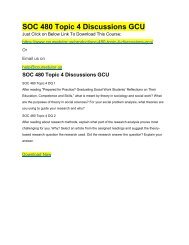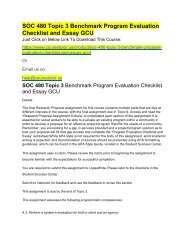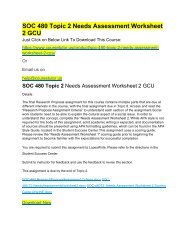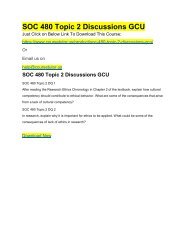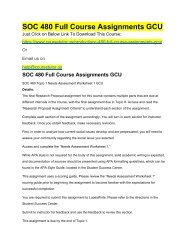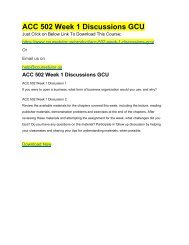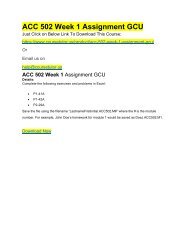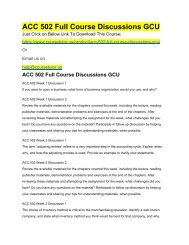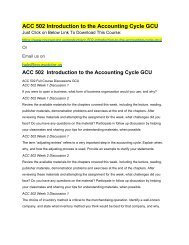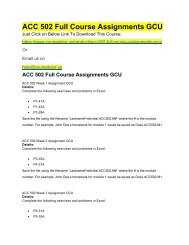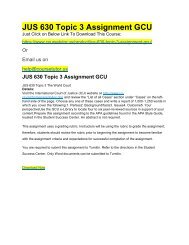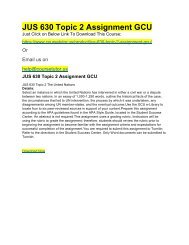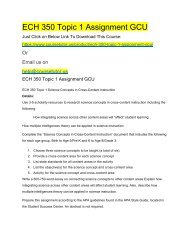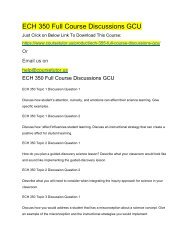CIS 505 Week 9 Discussions STR
You also want an ePaper? Increase the reach of your titles
YUMPU automatically turns print PDFs into web optimized ePapers that Google loves.
<strong>CIS</strong> <strong>505</strong> <strong>Week</strong> 9 <strong>Discussions</strong> <strong>STR</strong><br />
Just Click on Below Link To Download This Course:<br />
https://www.coursetutor.us/product/cis-<strong>505</strong>-week-9-discussions-str/<br />
Or<br />
Email us on<br />
help@coursetutor.us<br />
<strong>CIS</strong> <strong>505</strong> <strong>Week</strong> 9 <strong>Discussions</strong> <strong>STR</strong><br />
<strong>CIS</strong> <strong>505</strong> <strong>Week</strong> 9 Discussion 1<br />
Digital Transmission. Please respond to the following:<br />
Compare the data communication technologies of guided media and unguided media. This<br />
should include transmission media, data link control protocols, and multiplexing.<br />
Guided media is a physical path in which the signals prorogate; twisted pair, coaxial cable, and fiber<br />
optic. Unguided media usually employs an antenna for transmitting via air, vacuum, or water. Thus,<br />
the reason unguided transmission techniques are usually used for broadcast radio, terrestrial<br />
microwave, and satellite. Network environments are very costly due to the efforts need to protect<br />
transmission. High Level Data Link Control (HDLC) is a group of protocols or rules for transmitting<br />
data between network points. It’s one of the most used of many protocols. Data Link controls helps<br />
with the flow and error control of the transmission. Multiplexing aides in achieving transmission<br />
efficiency.<br />
An analog wave form (or signal) is characterized by being continuously variable along amplitude<br />
and frequency. In the case of telephony, for instance, when you speak into a handset, there are<br />
changes in the air pressure around your mouth. Those changes in air pressure fall onto the<br />
handset, where they are amplified and then converted into current, or voltage fluctuations. Those<br />
fluctuations in current are an analog of the actual voice pattern—hence the use of the term analog<br />
to describe these signals. Digital transmission is quite different from analog transmission. For one<br />
thing, the signal is much simpler. Rather than being a continuously variable wave form, it is a series<br />
of discrete pulses, representing one bits and zero bits. Each computer uses a coding scheme that
defines what combinations of ones and zeros constitute all the characters in a character set (that is,<br />
lowercase letters, uppercase letters, punctuation marks, digits, keyboard control functions).<br />
References<br />
http://www.informit.com/articles/article.aspx?p=24687&seqNum=5<br />
Digital transmission has several advantages over analog transmission. Analog circuits require<br />
amplifiers, and each amplifier adds distortion and noise to the signal. In contrast, digital amplifiers<br />
regenerate an exact signal, eliminating cumulative errors. An incoming (analog) signal is sampled,<br />
its value is determined, and the node then generates a new signal from the bit value; the incoming<br />
signal is discarded. With analog circuits, intermediate nodes amplify the incoming signal, noise and<br />
all. Voice, data, video, etc. can all by carried by digital circuits.<br />
References:<br />
http://web.cs.wpi.edu/~cs513/s07/week2-physcont.pdf<br />
<strong>CIS</strong> <strong>505</strong> <strong>Week</strong> 9 Discussion 2<br />
T-1 Lines. Please respond to the following:<br />
From the e-Activity, analyze the multiplexing techniques of DSL and cable modem Internet<br />
and suggest the one you prefer. Explain your decision.<br />
Multiplexing takes multiple signals and merges them into one, complex signal to be<br />
transmitted. Once the receiving devices catches the multiplexed signal, it is then divided into it’s<br />
original, multiple form. Cable modems use a new specification, named DOCSIS 3.1, to remain<br />
competitive and add multiple enhances. One of these enhancements is Orthogonal Frequency<br />
Division Multiplexing (OFDM). This transmission technique divides bandwidth into smaller subcarriers<br />
which helps decrease interference and allow for better data transmission on parallel<br />
channels. This standard provides the ability to define multiple downstream profiles on a single<br />
channel. The DOCSIS 3.1 specification also uses time and frequency multiplexing to transmit<br />
signals through a single channel. This makes OFDM and other legacy channels to operate<br />
simultaneously on separate or on the same frequencies.<br />
Compare and contrast the use of leased lines in a WAN or LAN setting. Then recommend<br />
what you would use if you were a CIO. Support your response with evidence or examples.
WANs are often built using leased lines. These leased lines involve a direct point-to-point<br />
connection between two sites. Point-to-point WAN service may involve either analog dial-up lines or<br />
dedicated leased digital private lines. An analog signal is a continuously varying electromagnetic<br />
wave that may be transmitted over a variety of media, depending on frequency. The principal<br />
advantages of digital signaling are that it is generally cheaper than analog signaling and is less<br />
susceptible to noise interference. Therefore, my recommendation would be in support of leasing<br />
lines in a WAN setting. A wide area network allows companies to make use of common resources<br />
in order to operate. Internal functions such as sales, production and development, marketing, and<br />
accounting can also be shared with authorized locations through this sort of network. The wide area<br />
network has made it possible for companies to communicate internally in ways never before<br />
possible.<br />
References:<br />
http://www.makeuseof.com/tag/technology-explained-wide-area-network-wan-tutorial/<br />
Download Now




